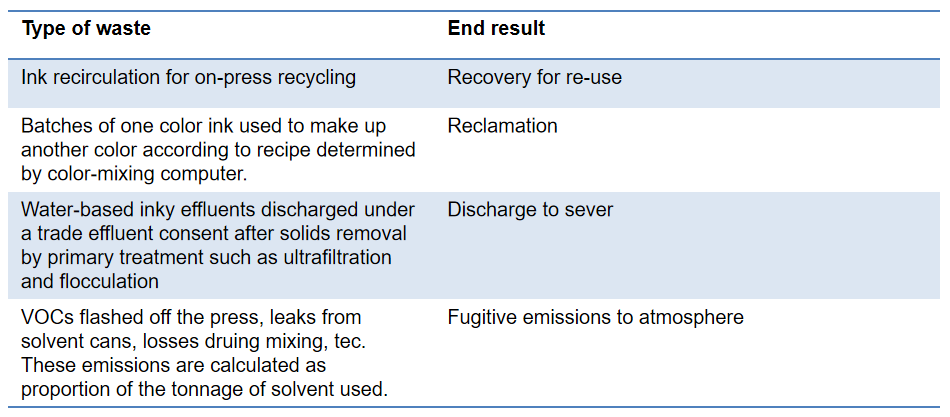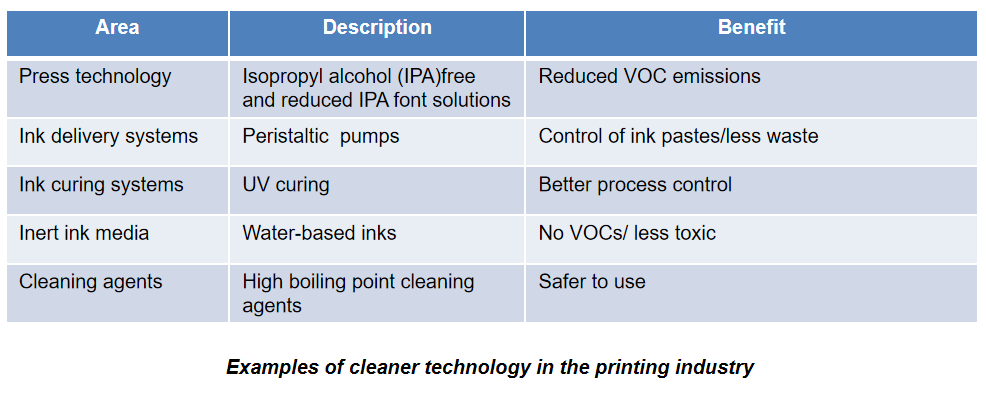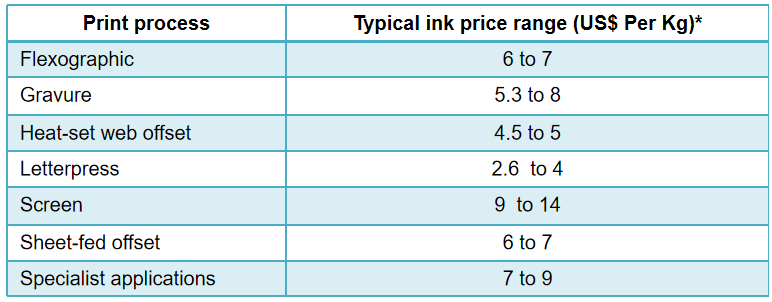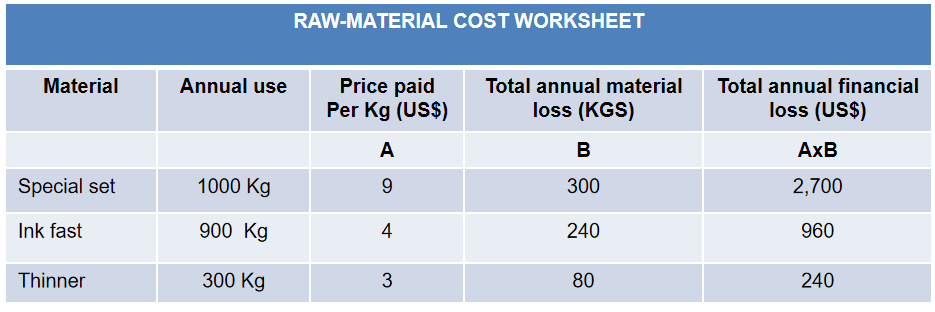Introduction
Ink is a high-performance material and plays a crucial role in printing operations. Ink waste in the middle east printing, packaging, and publishing industry amounts to over 2000 tons per year. The waste is worth US$ 10 million/year to the industry.
The good practice will help printers save money and improve their environmental performance by providing advice on how to reduce ink-related waste while maintaining printing speed, output, and quality.
This guide focus on achieving cost savings and other benefits through greater attention to ink management.
Advice is given on how to make cost-effective use of
- inks based on solvent, alcohol-based inks;
- inks based on vegetable and mineral oils;
- water-based inks;
- UV-cured inks.
Why take action to reduce inks waste?
In the printing process, the substrate (paper, polyethylene, polycarbonate, PVC, fabric, etc) generally represents 80-90% of the raw material costs of any printing product. The average substrate loss due to the printing process is estimated at 6%, within a range of 2-25% depending on the complexity of the job and the particular stage in the process.
The raw material cost of the inks in any printing job is usually only around 5% of the total cost. However, much of the substrate lost by printers as spoilage is a direct result of problems due to the ink not being applied in accordance with customer and or quality requirements.
Ink problems include wrong colors, hickeys, runs, drips, and failure to dry.
Reducing ink loss
- For every Kg of inks drawn from the stock for a job, printing industry estimates indicate an average of 60 gm will have been lost by the end of the job.
- Process losses include spillage, evaporation, and inky effluent generated during equipment cleaning. This 6% loss is repeated.
Reducing solvent use
- The use of solvent-based inks and organic cleaning agents leads to volatile organic compound(VOC) emissions from the printing process(refer to Good Housekeeping measures for Solvents)
Benefits of improved ink management

Why is ink wasted?
Operational reasons for ink-related waste include:
- a missed opportunity to purchase larger tins at the better value of money;
- inefficient ink mixing leading to over-production of special colours;
- inefficient ink delivery system leading to spillages lost time & injuries;
- poor press quality control leading to inks and substrate waste;
- inefficient ink recovery from the presses leading to the need for excessive cleaning and production of greater volumes of wash-down waste;
- poor stock control and unsuitable storage conditions leading to oversupply, ink degradation, and waste.
What happens to your ink-related waste?

Alternative inks and technologies
Some ink technologies – particularly UV-cured inks – produce much less waste. UV inks have been used for many years in the screen printing and sheet-fed offset sectors. Up to 15% of offset printers use UV inks and up to 25% of the volume, they produce UV-cured. More printers are now evaluating UV inks. The technique gaining acceptance by flexographic printers of packaging.
Other sectors of the printing industry already moved to adopt alternatives. Water-based inks have been used for flexographic printing in the Corrugated packaging sector for many years.
As a result, it has significantly lower operating costs than equivalent web offset printers still using inks based on aromatic and aliphatic hydrocarbons or alcohol.
However, when calculating operating costs, it is important to consider and take into account, labor costs, paper waste, ink waste, reclamation and recycling costs, press run, and maintenance costs.
Alternative technologies –proven cost and Environmental benefits

The Way forward
Any printing process – regardless of the type of ink and drying arrangement – will inevitably produce some waste.
Start by adopting a management strategy that includes:
- Identifying levels of process waste;
- systematic targeting of avoidable inks and substrate losses;
- examining reasons for over-consumption of ink;
- switching to inks that create less waste;
- identifying levels of emissions to air;
- systematic targeting of avoidable emissions to air;
This approach will allow you to decide whether savings can be made:
- within the context of existing operations;
- through a review of management practices;
- through adopting alternative ink or press technologies.
To help you improve your ink management, this guidelines describes:
- how to calculate the quantity of ink wasted;
- practicle measures to improve ink management and thus reduce ink and substrate waste;
- the benefits of improved technologies and alternative inks;
- examples of the benefits already achieved by companies that have taken action to improve their ink management practices.
M E A S U R I N G I N K L O S S E S
There are many benefits from measuring ink losses, including awareness of:
- raw material costs;
- additional cleaning, downtime and labor costs caused by ink losses;
- disposal costs of inky effluent, rags, organic solvents, etc
- examples of the benefits already achieved by companies that have taken action to improve their ink management practices.
TYPICAL INK COSTS

Estimation method – Raw material losses
The method, which is based on an average industry ink loss of 6%, estimates
- The total annual weight of inks and thinners lost during the printing process;
- The total annual value of inks and thinners lost during the printing process;

Action Steps to reduce & prevent effluence in print operations
On Press
- Set goals to minimize make-ready waste. Regularly track and compare make-ready waste (as a percentage of acceptable printed product)with goals
- Establish and follow standard procedures for checking on-press registration.
- Develop and document recommended press settings for each press for most common substrate and ink combinations
- Record substrate, ink, press and press settings for all possible re-run jobs, to reduce make-ready on subsequent runs
- Implement an effective program to ensure that color requirements and other job specifications are thoroughly understood and can be tracked throughout prepress and production.
- Improve press-side housekeeping to prevent ink from drying on anilox rolls. To prevent : monitor and adjust ink viscosity and pH; correctly adjust doctor blade pressure; monitor ambient air humidity and adjust if necessary; maintain proper press speed.
Action Steps
- Clean anilox rolls and other press parts adequately and immediately to reduce the amount of solvent needed for cleaning.
- Considering alternate anilox cleaning methods such as blasting with baking soda or carbon dioxide
- Check color during make-ready and production with spectrophotometer and densitometer.
- Reduce ink waste by reviewing ink estimation methods to ensure they are as accurate as possible.
- Schedule work on presses to minimize color changes and print station cleanups
- Evaluate waste-ink management practices to assure that no inks are improperly disposed of and potential liabilities are minimized
- Eliminate lead, mercury, cadmium, and chromium-based pigments
- Maintain and use an accurate, current, and readily accessible inventory of ink stock, including partially-used containers. Use current ink stock whenever possible.
- Train employees on proper product-transfer techniques, including pumping and pouring, to minimize waste
- Increase use of low-VOC inks. Consult the supplier to determine if you are using the ink with the lowest VOC content to achieve the desire results.
- Use reverse-angle doctor blade to reduce ink consumption and improve print quality.
- Use an automatic ink delivery system to reduce the amount of waste ink generated.
- Consider water-based inks
- Consider ultaravoilet(UV)curable inks & electron beam (EB)curable inks.
- Use enclosed doctor blade chambers that minimize ink evaporation and have automated cleaning to reduce solvent use.
- Use containers that deliver a controlled amount of solvent to a shop towel, and keep containers closed.
- Use parts washer with low-VOC or low-vapor pressure solvent to clean removable press parts (e.g. trays)
Action Steps – Customer Relations
- Review and maintain clear communication, both internally and externally; know what your customers want so that you get the order right the first time and minimize waste.
- Work with customers during the job design to show how to modify the layout to minimize substrate.
- Whenever using alternative materials, follow up on customer jobs to sample satisfaction with products. This will help you fully understand customer interest and satisfaction with environmentally preferable inks and substrate.
- Encourage customers, through the use of incentives(e.g., price, time, or services) to make choices that help you achieve your environmental objectives. Encourage use of existing inventory of ink; inks reblended from stock; substrate leftover from other jobs.
- Provide training to staff to help them recognize the opportunities in working with customers to reduce wastes and emissions
Action Steps – Input Materials
- Limit samples to the smallest required amount. Return unused portions of samples to suppliers to reduce waste costs.
- Inspect incoming materials. Refuse delivery of damaged or improperly labeled containers or materials.
- Ensure inventory management practices intentionally use the oldest material first.
- Reduce container waste by ordering bulk purchases(e.g. ink, solvent) if high volume usage is occurring.
- If the product expiration date listed by the manufacturer has passed, when economically/technically feasible, test materials to determine if they are still suitable for use.
Action Steps – Improve your House Keeping
- Make sure container lids are tight-fitting and in place whenever the product is not being used. This will prevent loss of ink and thinners through evaporation or spillage.
- Ensure the facility is clean, neat, and well lighted.
- Keep garbage separate from recyclable materials,
- Segregate hazardous waste from non-hazardous waste
- Install and maintain a system to prevent unintentional spills or leaks from entering sanitary sewers (for example, seal floor drains and/or install leakproof beams around chemical storage areas)
Action Steps – Press run Print Checks
At this stage of the printing process, there is the potential to waste large amounts of inks and substrate if the product does not meet the required standard. Every time you put reject in the recycling bin, a number of inks and substrate is wasted.
Quality checks are essential. The more often they are programmed into your procedures, the less likely that quality will deteriorate. Poor quality product means wasted substrate, ink, and effort.
- On-line print quality checks may include color mating to a standard and checks for:
-dot gain;
-opacity;
-cracking;
-adhesion;
-rub fastness;
-on plastics, checks for crazing. - Depending on the volatility of the ink, viscosity checks should be made regularly during long print runs.
- These checks can be carried out manually with hand-held viscometers or zhan cups.
About the Author:
Mohammed Abdul Haleem
Email: packagingprinting@consultant.com
With almost 27 years of experience in the printing industry, he offers proactive recommendations on anilox roll specifications, flexographic printing sleeves, testing, inventory management, flexographic equipment applications, training, representation from experience in technical sales, marketing, production, technical service, parts, and supplies. His experience covers the spectrum of flexographic markets including wide web flexible packaging, narrow web, tag & labels, foil, folding carton, corrugated packaging applications.


